Abstract
Nanoparticles of transition metal dichalcogenides (TMDC) have been known to reduce friction and wear when added to oil-type liquid lubricants. Aggregation limits the ability of the nanoparticles to penetrate into the interface between the two rubbing surfaces—an important factor in friction reduction mechanisms. Doping has been successfully used to reduce agglomeration, but it must be done in the production process of the nanoparticles. The use of surface-functionalized nanoparticles is less common than doping. Nonetheless, it has the potential to reduce agglomeration and thereby improve the reduction of friction and wear. In this study, we present the results of preliminary tribological ball-on-flat tests performed with WS2 nanoparticles functionalized by a humin-like conformal shell, as additives to polyalphaolefin-4 (PAO-4) oil. We tested WS2 inorganic nanotubes (INTs) and two grades of inorganic fullerene-like nanoparticles (IFs). The shell/coating was found to improve friction reduction for IFs but not for INTs through better dispersion in the oil. The thicker the coating on the IFs, the less agglomerated they were. Coated industrial-grade IFs were found, by far, to be the best additive for friction reduction. We suggest the combination between reduced agglomeration and poor crystallinity as the reason for this result.
1. Introduction
In the last few decades, nanoparticles (NPs) have been widely studied and used to reduce both friction and wear. Inorganic NPs with lamellar anisotropic structure are good candidates for lubrication. They provide high compression strength and low shear strength. Examples of such materials are chlorides, borates and oxides of transition metals. Within this group, the transition metals dichalcogenides (TMDC) excel at tribological applications. TMDCs are sulfides, selenides and tellurides of the transition metals tungsten, molybdenum, tantalum, titanium, and niobium. Molybdenum disulfide (MoS2) and tungsten disulfide (WS2) are by far the most studied in tribology, somewhat in their nanotube (INT) form, but much more extensively in their fullerene-like particle (IF) form. These polyhedral onion-like nanostructures were first discovered by Tenne et al. in 1992 [1] and have constantly shown the ability to improve the tribological properties of different systems ever since. Lower friction and wear can be achieved by adding TMDC NPs to oils [2,3,4,5,6,7,8] or by incorporating them in solid matrices [6,9,10,11,12] and in coatings [13,14,15,16,17].
The mechanisms of friction reduction by TMDC NPs are also a widely researched topic. They have been studied both by theoretical-computational techniques and by experimental-analytical methods such as electron microscopy, atomic force microscopy (AFM), and X-ray photoelectron spectroscopy (XPS) [6,7,10,16,17,18,19,20,21,22,23,24,25,26,27,28]. Generally, there are three main mechanisms considered. The first friction reduction mechanism is the sliding motion of the NP, where it maintains its shape. The NPs can penetrate into the grooves between two rough surfaces and serve mainly as a separator between the two rubbing surfaces. The second mechanism occurs when pressure increases and a rolling motion begins to take place, causing the nanoparticle to act as a tiny ball bearing. A further increase in pressure causes the nanoparticle to reach the limits of its elasticity, and the third mechanism emerges. Layers are exfoliated from the nanoparticle, forming a protective layer, or a tribofilm, on the surface.
Among the important parameters that influence the friction reduction provided by TMDC nanoparticles is their ability to penetrate the interface between the rubbed surfaces [18]. These nanoparticles, especially WS2 IFs [19], tend to come in agglomerated forms. The agglomerates are hard to disperse in oil. Disturbing the particles through sonication or extended mixing times can sometimes help to disperse the NPs in the oil, but not always. As a result, the nanoparticles will have limited access to the rubbed surfaces. If the aggregate is larger than the gap between the surfaces, the NPs will not even be able to enter, and so will be unable to reach the interface and aid in lubrication [20,24].
One strategy to increase the stability of TMDC NPs-in-oil dispersion is doping. Preparation of doped TMDC nanoparticles is not new to the literature. For example, nanostructures of WS2 and MoS2 doped with carbon [29], titanium [30], or niobium [31] were reported more than a decade and a half ago. Later, the preparation of rhenium-doped TMDC IFs was reported [32]. Doping seems to have a positive effect on the tribological properties of the NPs. Tannous et al. [33] tested a series of MoxW1-xS2-type of IFs as oil additives using a pin-on-flat setup in order to determine their effect on friction and wear. They found that 0.5 < x ≤ 0.8 and x = 1 IFs gave the best results. A possible explanation is the presence of lattice defects, which facilitate exfoliation. In another study, the doping of MoS2 IFs with less than 1 at. % of rhenium led to better dispersion in oil and to ultra-low friction coefficient (Coefficient of Friction, CoF) values. Here, negative surface charges caused by the doping may explain repulsion between the NPs and, in turn, an improved tribological behavior [34]. Recently, Cammarata and Polcar [35] used ab initio density functional theory techniques to study how structural and electronic features of TMDC NPs affect their tribology on the macroscopic scale. They also used their design to engineer a titanium-doped MoS2 NP that is expected to have enhanced tribological properties. A possible technical drawback to doping is the fact that it must be done as a part of the synthesis of TMDC NPs.
Another strategy to reduce agglomeration is to functionalize non-doped NPs. As they are relatively chemically inert in their bare form, surface functionalization of TMDC NPs, resulting in nanocomposite material formation, can potentially help in achieving better dispersion ability and in reducing agglomeration [24]. Still, compared to the doping method, there are few studies found in the literature that address the tribological properties of surface-functionalized NPs. Shahar et al. [36], who performed tribological measurements on silane-coated WS2 IFs, found that alkyl-silane functionalization increased the stability of oil-nanoparticle dispersions. In tests done one and two hours after the sonication of the functionalized nanoparticles in oil, the CoF values decreased by 33% compared to non-functionalized nanoparticles. A more recent work was reported by Yegin et al. [37], who worked with silica NPs as additives to an ionic liquid-type of lubricant. They found that octadecyltrichlorosilane-functionalized NPs reduced the CoF by 37.2% compared to bare ionic liquids, whereas non-functionalized silica NPs reduced the CoF by only 16.7%. Moreover, the functionalized NPs combined the advantages of a hard core and a soft shell.
For this work, our main goal was to get a preliminary idea about the tribological behavior of WS2 nanostructures functionalized with a humin-like conformal shell, which we recently reported the preparation and characterization of [38]. More specifically, we wanted to determine if the conformal shell leads to an improvement in the friction reduction by providing the NPs better access to the rubbed surfaces. Other parameters of interest were the effects of the shell thickness and the type of coated NP on the tribological properties.
2. Materials and Methods
2.1. Preparation of Humin-Like Shell-Coated WS2 NPs
Humin-like shell-coated WS2 NPs were prepared based on a procedure we previously published [38], scaled up for a 100-mL round-bottom flask (for quantities of the reagents, see Table 1). Multi-walled WS2 INTs/IFs were purchased from NanoMaterials Ltd. (Yavne, Israel). For the samples IF-IND-1 and IF-IND-2, industrial-quality IFs were used. For the rest of the samples, laboratory-quality INTs and IFs were used. NPs were dispersed in 25 mL of chloroform (ACS reagent, Carlo Erba, Milan, Italy). A solution of glucose pentaacetate (98%, Acros Chemicals, Geel, Belgium, Cat. No. 119910250) in 25 mL was then added, followed by BF3·Et2O (Sigma-Aldrich, Rehovot, Israel, Cat. No. 175501). The reaction flasks were heated to 60 °C and stirred for 24 h. After cooling to room temperature, the samples were washed and dried (for a more detailed procedure, refer to [38]).

Table 1.
Data for preparation of coated WS2 NPs.
2.2. Tribological Tests
All tests were performed using a reciprocal ball-on-flat setup (Figure 1). The tests were performed using a load of 2.8 N and a sliding velocity of 1.5 mm/s over 3000 cycles. A steel-bearing ball (AISI 50100) with a diameter of 5 mm was moved against a stainless steel plate (AISI 316) with a hardness of 23–24 HRc. The flat plates were ground up to Ra = 0.1 µm. Three drops of polyalphaolefin-4 (PAO-4) oil (viscosity 18 mPa·s at 40 °C; Paz Oil Company Ltd., Haifa, Israel) with or without 1% (wt %) WS2 NP additives were added at the beginning of each 1000 cycles at the interface between the ball and the plate. The CoF and the wear (width of track) were measured during the tests. The experimental setup was developed and built in Holon Institute of Technology (HIT, Holon, Israel). All tests were performed at room temperature (23–24 °C, humidity 45–55%) and repeated 3 times for each sample.
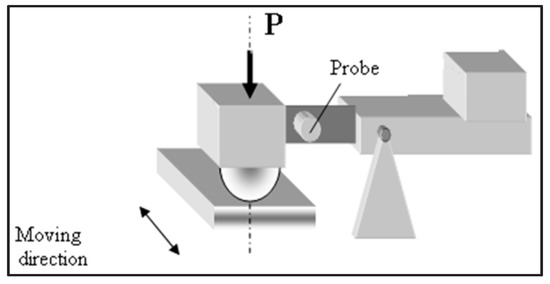
Figure 1.
Schematic illustration of the ball-on-flat rig.
It is important to state that this work is our first with such functionalized WS2 NPs, and the tribology tests performed here were meant to get a preliminary idea about their potential as additives compared to non-functionalized ones. There are more parameters to be tested within the experimental setup, like changes in the speed and load. In addition, conditions such as mixing time and temperature are to be evaluated by sedimentation tests, similarly to our previous work with non-functionalized WS2 IFs [39].
2.3. Electron Microscopy Characterizations
HRSEM images and elemental EDS mappings were acquired using a Magellan 400L high-resolution scanning electron microscope (FEI, Hillsboro, OR, USA) equipped with an EDS detector. After the friction test, the plates were carefully rinsed with hexane (95%, Sigma-Aldrich, Rehovot, Israel, Cat. No. 296090) and air-dried.
Transmission electron microscopy (TEM) images were acquired by a Tecnai Spirit Bio-Twin microscope (FEI, Hillsboro, OR, USA) equipped with a 1 × 1 k CCD camera (Gatan, Pleasanton, CA, USA). Samples for TEM analysis were dispersed in ethanol, placed on a formvar/carbon film on a 400-mesh copper TEM grid (FCF400-Cu, Electron Microscopy Sciences, Hatfield, PA, USA) and dried.
3. Results
3.1. Preparation of Humin-Like Shell-Coated WS2 Nanostructures
TEM images (Figure 2) show WS2 NPs coated with a conformal humin-like shell of different thicknesses, similarly to a previous report [38]. Here, too, no electron diffraction is obtained from the shell, meaning it is amorphous. Additionally, as expected, the shell thickness increases with an increasing glucose pentaacetate/WS2 ratio (as seen in images b, c and e–g). Another point worth noting is the visual difference between the two grades of WS2 IFs. The non-coated laboratory-quality IFs (d) have a well-defined, pebble-like shape, and their walls seem to be intact. The non-coated industrial-quality IFs (h) seem to be more damaged and some of their external walls are exfoliated.
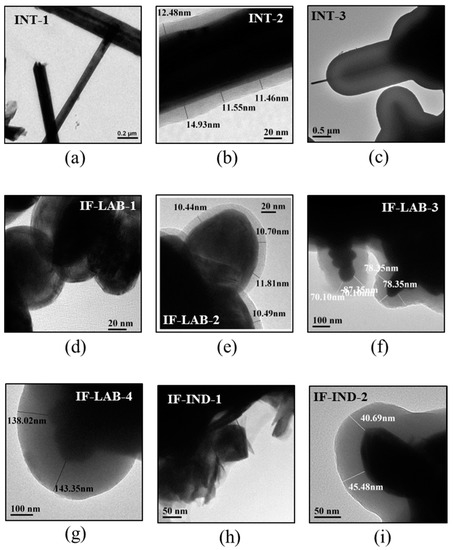
Figure 2.
Transmission electron microscopy (TEM) images of the non-coated and coated WS2 INTs (a–c), laboratory-quality WS2 IFs (d–g), and industrial-quality WS2 IFs (h,i), tested as oil additives for friction reduction.
3.2. Friction and Wear Experiments
The results of the friction and wear tests are presented in Table 2.

Table 2.
Typical coefficients of friction (CoF) and widths of wear tracks for additive-free oil and oil with additives.
It can be seen that the highest values for both parameters were obtained for additive-free PAO-4: 0.17 and 235 µm, respectively. For friction tests with additives, the CoF values are relatively close to each other and do not follow any specific trend. Coated INTs do not improve the friction and wear properties compared to non-coated INTs. The case is different for IFs: the width of wear track decreases for the group of laboratory-quality WS2 IFs, the thicker the humin-like shell is. Coated industrial-quality WS2 IFs give the lowest values for both CoF and width of wear track: 0.075 and 70 µm, respectively. These values make them the most preferred additive to PAO-4 for friction and wear reduction.
To explain the results of the friction and wear tests, we first explore the morphology of the rubbed surfaces by examining the optical microscope (OM) images. Figure 3 and Figure 4 show OM images of the wear spots on the surface of the balls and the wear tracks after 3000 cycles of friction.

Figure 3.
Optical microscope (OM) images of wear spots on the surface of the ball and wear tracks after friction tests in PAO-4 oil with WS2 IFs samples used as additives (a): non-coated laboratory-quality (ai,aii); coated laboratory-quality (aiii–avi); (b): non-coated industrial-quality (bi,bii); coated industrial-quality (biii,biv).
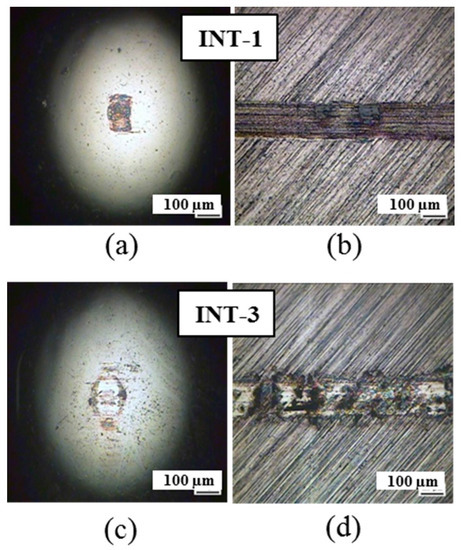
Figure 4.
OM images of wear spots on the surface of the ball and wear track after friction tests in PAO-4 oil with WS2 INTs samples used as additives: non-coated (a,b) and coated (c,d).
It can be seen that for the tests with IFs additives (Figure 3), transferred films and thin plowing marks are observed in the wear tracks. When looking at the balls, similar plowing marks and transferred films around the wear spot are visible only for the tests with non-coated IF-LAB-1 nanoparticles (ai). Clearly, the distribution of the nanoparticles around the wear track plays an important role in friction reduction for the IF-LAB series. In fact, non-coated WS2 IFs are spread in relatively large aggregates of nanoparticles both on the surface of the ball and on the flat plate (ai,aii). For the coated sample IF-LAB-3, the aggregates are almost absent (av,avi). Visible aggregation decreases with increasing coating thickness, and this sits well with the wear track values shown in Table 2.
A difference in aggregation between the coated and non-coated samples cannot be concluded solely from these OM images for the tests with industrial-quality WS2 IFs (bi–biv). There seems to be a concentration of IFs in the track margins in image bii compared to small clusters of IFs in image biv, but a deeper look into the wear track is required, particularly for sample IF-IND-2 which gave the best results for friction and wear reduction.
For the tests with INTs additives (Figure 4), OM images of the contact surfaces during friction agree with the results in Table 2: the CoF and width of the wear track seem to be the lower for the non-coated INTs compared to the coated ones. It was found that the non-coated INTs form a thin film on both contact surfaces (a,b). For coated INTs (c,d), no transferred film is observed on the ball surface, and big clusters of INTs appear around the wear track. As the coating does not improve the friction reduction ability of WS2 INTs, we will present a deeper examination of the IFs tests. We will, however, further discuss the different friction reduction mechanisms of IFs and INTs in the discussion section. To better understand the role of the coating and the differences between IFs grades regarding friction and wear reduction, HRSEM images of the wear tracks were analyzed (Figure 5).

Figure 5.
High resolution scanning electron microscope (HRSEM) images of wear tracks after friction tests for coated and non-coated: laboratory-quality WS2 IFs (a–f) and industrial-quality WS2 IFs (g–i) tested as oil additives for friction reduction.
The images display an obvious difference in the nanoparticles’ distribution within the tracks. For sample IF-LAB-1, large clusters of the non-coated IFs are seen around the wear track and with only a few clusters within the track (a). A closer look (b) at the area circled in red reveals densely packed, micron-sized aggregates of nanoparticles. This means that a large portion of the aggregates cannot penetrate the interface. The NPs in the lubricant containing IF-LAB-2, with a thin coating, still form large clusters. The clusters are concentrated mostly in the track margins, a few are found within the track, and unlike the non-coated IFs, far fewer clusters are seen outside of the track area. The NPs in the lubricant containing IF-LAB-3, with a thicker coating, form tiny clusters (almost not visible under low magnification), allowing them to penetrate the grooves in the interface and successfully fill them.
Non-coated industrial-quality IF-IND-1 nanoparticles are seen all over the plate area (g) but in much smaller clusters (h) compared to the equivalent sample of laboratory-quality IFs (b). Images b and h also show the difference between the two grades of IFs that were seen in the TEM images: laboratory grade IFs have a more defined and closed structure than the industrial grade IFs.
Coated industrial-quality IF-IND-2 nanoparticles were found to be the most efficient for friction reduction. Image i shows very low wear on the tested plate and even smaller clusters of IFs compared to the IF-IND-1 sample. A closer look into the wear track (j) shows that single IFs or clusters of a few IFs can be seen.
HRSEM images give us a hint about the role the coating plays in reducing the friction. The images imply that coated IFs tend to be less aggregated than non-coated IFs, allowing them better access into surface features. The images of the plates tested with IF-LAB-3 and IF-IND-2 additives demonstrate this well (Figure 5f,j). To get a better idea of the difference between the two IFs grades, EDS elemental mappings were used. We compared the abovementioned samples with their non-coated equivalents IF-LAB-1 and IF-IND-1, respectively. Figure 6 shows elemental EDS mappings and compositional data for the plates tested with laboratory-quality IFs as additives to PAO-4 oil.
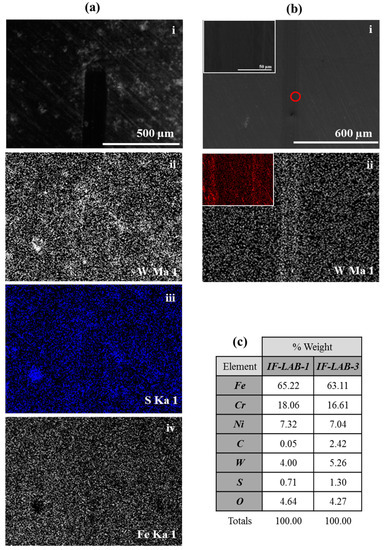
Figure 6.
EDS elemental mappings for plates tested with (a) non-coated IF-LAB-1: mapped area (ai), tungsten (aii), sulfur (aiii) and iron (aiv); (b) coated IF-LAB-3: mapped area (bi), and tungsten (bii); (c) comparative chemical compositions.
On the plate tested with non-coated IFs (a), tungsten and sulfur signals are found over the entire tested area with no preference regarding the wear track. On the plate tested with coated IFs (b), the tungsten signal is clearly stronger within the wear track. A higher magnification (inset image ii) shows stronger tungsten signals in the scratches and dents, implying that the coated IFs entered these surface features. Generally speaking, even though the coated IFs did access the wear track, it does not contain a significant amount of them: looking at the compositional data (c), percentages of tungsten, sulfur and carbon are only slightly higher for the IF-LAB-3 sample compared to IF-LAB-1. In addition, out of the elements contained in the coated IFs, tungsten was the only one detectable in the mapping. The following comparison to industrial-quality IFs will emphasize this point.
Figure 7 shows elemental EDS mappings and compositional data for the plates tested using industrial-quality IFs as additives to PAO-4 oil. On the plate tested with non-coated IFs (a), both tungsten and sulfur signals appear on the entire tested area. The tungsten signal, however, (ii) is slightly stronger within the wear track than in the rest of the tested area. On the plate tested with coated IFs (b), the contrast in the tungsten mapping (ii) is stronger compared to (aii). The same goes for sulfur and carbon. A closer look into the wear track on this plate (inset images bii–bv) and the compositional data (c) implies a high “concentration” of the coated IFs in the wear track. Additionally, the coated IFs are filling the scratches and dents in the wear track so well that an iron “absence” in the filled parts is clearly noticeable (inset image bv).
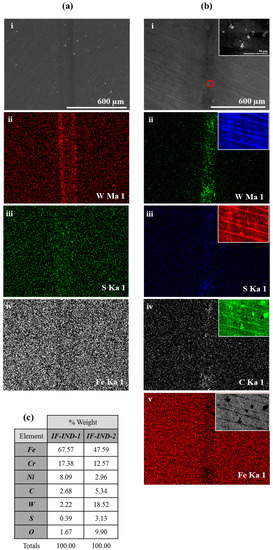
Figure 7.
EDS elemental mappings for plates tested with (a) non-coated IF-IND-1: mapped area (ai), tungsten (aii), sulfur (aiii) and iron (aiv); (b) coated IF-IND-2: mapped area (bi), tungsten (bii), sulfur (biii), carbon (biv), and iron (bv); (c) comparative chemical compositions.
To further verify the connection between the presence of the shell on the WS2 IFs and the effect of disaggregation which plays a role in friction reduction, we compared between 1% (wt %) dispersions of coated and non-coated IFs in paraffin oil, under an optical microscope (Figure 8). The dispersions were prepared by stirring the particles with the oil for one hour at room temperature, using a magnetic stirrer. Then, three drops of the dispersions were placed on clean glass slides and observed under the microscope.
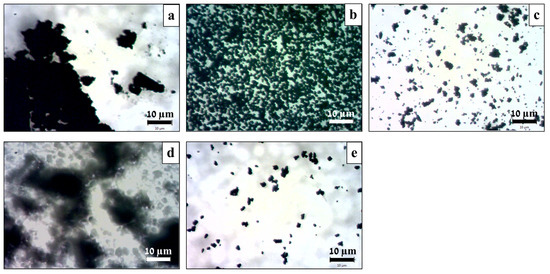
Figure 8.
OM images of 1% dispersions of coated and non-coated WS2 IFs in paraffin oil: (a) IF-LAB-1; (b) IF-LAB-2; (c) IF-LAB-3; (d) IF-IND-1; (e) IF-IND-2.
For both the laboratory- and industrial-quality IFs, there is a clear difference between the dispersions of non-coated IFs (a,d) and the dispersions of the coated IFs (b,c,e). While the non-coated IFs are present in the oil as large (tens of microns long) “islands” or aggregates, the coated IFs form much smaller clusters. In the image of industrial-quality non-coated IFs (d), exfoliated walls from the nanoparticles are clearly observed in the background. Another point worth noticing is the difference between the laboratory-quality IFs with different coating thicknesses (b,c). Both types of coated particles form small clusters, but the clusters of the thinly coated nanoparticles (b) are much more densely packed compared to the particles in image (c), with the thicker coating. A possible explanation is that the thin coating might help separation between the particles, but does not induce sufficient repulsion interactions to in comparison to the thicker coating. Out of all of the IFs groups, the coated industrial-quality WS2 IFs (e) appear to be dispersed in small clusters with the largest spaces between them.
4. Discussion
Both WS2 INTs and IFs showed some improvement in reducing friction compared to additive-free PAO-4 oil, as expected. When comparing INTs and coated IFs, it appears that the coating affects each of them in opposite ways: coated IFs reduce friction better than non-coated IFs. In contrast, coated INTs do not reduce friction as well as the non-coated INTs. As mentioned in the introduction section, the use of metal dichalcogenide IFs for lubrication is well-studied in the literature. The use of INTs for lubrication, however, is much less common. With this being said, INTs do reduce friction and wear to some extent [40,41]. The friction reduction mechanisms of the INTs and IFs in relation to this study will be discussed here.
Kalin et al. [40], in their tribological tests done with MoS2 nanotubes, suggested two main mechanisms for friction reduction. The first mechanism is exfoliation of the nanotube walls, leading to formation of tribofilm in the wear track. The second mechanism is the aggregation of compacted and accumulated nanotubes, mainly at the margins of the wear track, acting as a thick film barrier and reducing friction. With INTs, unlike IFs, penetration into surface features is less relevant as a mechanism for reducing friction. This is due to the rod-like shape and micron-scale lengths of the nanotubes. In the case of our work, the conformal coating supposedly has a negative effect on both mechanisms: it most likely protects the nanotubes from exfoliation and it makes the nanotubes less likely to aggregate. Therefore, it makes sense that the non-coated WS2 INTs were more capable of reducing friction than the coated WS2 INTs.
The story is different for IFs. As mentioned, WS2 IFs commonly form large aggregates, leaving exfoliation of the IFs walls to become the dominant friction reduction mechanism. On one hand, the conformal coating we present here might protect the IFs from in situ exfoliation, strongly reducing its role as a friction reduction mechanism. On the other hand, however, surface functionalization of WS2 IFs helps to improve their dispersion, therefore reducing aggregation. We are assuming the reason for this is that the humin-like conformal shell may make the surface of the NPs somewhat lipophilic and hence more easily dispersed in an oily medium [24]. Smaller aggregates of IFs show a better ability to reduce friction and protect the rubbed surface from direct metallic contact, thus decreasing the wear on the surface [36]. There is also a role played by the thickness of the coating. We previously reported that as the coating thickness increases, coated IFs powder is finer and more free-flowing [38]. This leads to better dispersion of the IFs in oil as the coating thickness increases. This effect is well demonstrated in OM images of the particles-in-oil dispersions, and the SEM images of the IFs plates after friction tests.
Coated industrial-quality IFs gave the best results in our friction tests. The reason for this is most likely the combination of the two parameters of friction reduction mechanisms described above for IFs: tribofilm formation and easy penetration into the interface. It has been reported that poorly crystalline MoS2 IFs presented better tribological properties then their perfectly shaped, closed-caged equivalents, as surface defects facilitate exfoliation and the formation of tribofilm [25,33,42]. The industrial-quality WS2 IFs in our work are poorly crystalline and highly exfoliated to begin with, which is an advantage in friction reduction when comparing these two grades. In addition to the pre-exfoliated walls, which make a tribofilm formation easier, the coating adds a disaggregating effect, making the surface penetration mechanism more efficient. Hence, it is not surprising that the test performed with coated industrial-quality IFs resulted in significantly lower values for CoF and track width compared to the rest of the tested samples.
5. Conclusions
In this work, we tested WS2 INTs and IFs coated with a conformal humin-like shell as additives to PAO-4 oil for friction reduction using a ball-on-flat setup. Two grades of IFs were tested, and different coating thicknesses were examined. From this research, the following conclusions can be drawn:
- Coated WS2 INTs did not show any improved friction and wear properties compared to the non-coated ones. The reason is that the formation of a tribofilm is the dominant mechanism in friction reduction for INTs. This mechanism is assisted by exfoliation and accumulation, which are both interrupted by the presence of the coating.
- In contrast, coated WS2 IFs showed an improved ability to reduce friction and wear compared to the non-coated ones. The improved tribological properties of the coated IFs are explained by the reduced aggregation the coating provides, allowing better dispersion of the IFs in the oil phase. This leads to a better penetration of the IFs into the interface, providing easy shearing at thin surface layers. As the coating thickness increases, so too does the friction reduction provided by the NPs, because the aggregation decreases.
- Coated industrial-quality WS2 IFs, used as a PAO-4 additive, gave the best friction reduction results. This is associated with a combination of two mechanisms: the presence of pre-exfoliated walls facilitates tribofilm formation, and the disaggregating effect of the coating makes it easier for the NPs to penetrate the interface.
Performing sedimentation tests is a significant part of our future work with the functionalized NPs. Optimized mixing conditions and experimental setup may lead to an additional improvement in the friction reduction enabled by the coated IFs.
Another interesting aspect to test is IFs with various other chemically different conformal coatings as lubrication additives. In any case, it is our hope that these preliminary findings will be of help with further improvement of metal dichalcogenides nanostructures tribological properties.
Acknowledgments
We thank NanoMaterials Ltd. for their generous gift of WS2 nanotubes and fullerene-like nanoparticles. We thank the Israel National Nanotechnology Initiative for partial funding of this research. We thank Merav Muallem and Ortal Lidor-Shalev (Bar-Ilan University, Institute for Nanotechnology and Advanced Materials) for dedicating the time to provide us with their kind and professional help in producing the HRSEM images and EDS analysis for this paper.
Author Contributions
H.S. Prepared and analyzed the functionalized nanoparticles. A.M. and L.R. conceived and designed the tribology experiments; A.M. performed the tribology experiments; A.M. and H.S. analyzed the data; J.-P.L. and L.R. contributed reagents/materials/analysis tools; H.S. wrote the paper. L.R., A.M. and J.-P.L. revised the paper and approved submission.
Conflicts of Interest
The authors declare no conflict of interest.
References
- Tenne, R.; Margulis, L.; Genut, M.; Hodes, G. Polyhedral and cylindrical structures of tungsten disulphide. Nature 1992, 360, 444–446. [Google Scholar] [CrossRef]
- Rapoport, L.; Bilik, Y.; Feldman, Y.; Homyonfer, M.; Cohen, S.R.; Tenne, R. Hollow nanoparticles of WS2 as potential solid-state lubricants. Nature 1997, 387, 791–793. [Google Scholar] [CrossRef]
- Golan, Y.; Drummond, C.; Homyonfer, M.; Feldman, Y.; Tenne, R.; Israelachvili, J. Microtribology and Direct Force Measurement of WS2 Nested Fullerene-Like Nanostructures. Adv. Mater. 1999, 11, 934–937. [Google Scholar] [CrossRef]
- Cizaire, L.; Vacher, B.; Mogne, T.L.; Martin, J.M.; Rapoport, L.; Margolin, A.; Tenne, R. Mechanisms of ultra-low friction by hollow inorganic fullerene-like MoS2 nanoparticles. Surf. Coat. Technol. 2002, 160, 282–287. [Google Scholar] [CrossRef]
- Rapoport, L.; Leshchinsky, V.; Lapsker, I.; Volovik, Y.; Nepomnyashchy, O.; Lvovsky, M.; Popovitz-Biro, R.; Feldman, Y.; Tenne, R. Tribological properties of WS2 nanoparticles under mixed lubrication. Wear 2003, 255, 785–793. [Google Scholar] [CrossRef]
- Rapoport, L.; Leshchinsky, V.; Volovik, Y.; Lvovsky, M.; Nepomnyashchy, O.; Feldman, Y.; Popovitz-Biro, R.; Tenne, R. Modification of contact surfaces by fullerene-like solid lubricant nanoparticles. Surf. Coat. Technol. 2003, 163–164, 405–412. [Google Scholar] [CrossRef]
- Greenberg, R.; Halperin, G.; Etsion, I.; Tenne, R. The Effect of WS2 Nanoparticles on Friction Reduction in Various Lubrication Regimes. Tribol. Lett. 2004, 17, 179–186. [Google Scholar] [CrossRef]
- Joly-Pottuz, L.; Dassenoy, F.; Belin, M.; Vacher, B.; Martin, J.M.; Fleischer, N. Ultralow-friction and wear properties of IF-WS2 under boundary lubrication. Tribol. Lett. 2005, 18, 477–485. [Google Scholar] [CrossRef]
- Rapoport, L.; Leshchinsky, V.; Lvovsky, M.; Lapsker, I.; Volovik, Y.; Feldman, Y.; Popovitz-Biro, R.; Tenne, R. Superior tribological properties of powder materials with solid lubricant nanoparticles. Wear 2003, 255, 794–800. [Google Scholar] [CrossRef]
- Rapoport, L.; Nepomnyashchy, O.; Lapsker, I.; Verdyan, A.; Moshkovich, A.; Feldman, Y.; Tenne, R. Behavior of fullerene-like WS2 nanoparticles under severe contact conditions. Wear 2005, 259, 703–707. [Google Scholar] [CrossRef]
- Rosentsveig, R.; Margolin, A.; Gorodnev, A.; Popovitz-Biro, R.; Feldman, Y.; Rapoport, L.; Novema, Y.; Naveh, G.; Tenne, R. Synthesis of fullerene-like MoS2 nanoparticles and their tribological behavior. J. Mater. Chem. 2009, 19, 4368–4374. [Google Scholar] [CrossRef]
- Simić, D.; Stojanović, D.B.; Kojović, A.; Dimić, M.; Totovski, L.; Uskoković, P.S.; Aleksić, R. Inorganic fullerene-like IF-WS2/PVB nanocomposites of improved thermo-mechanical and tribological properties. Mater. Chem. Phys. 2016, 184, 335–344. [Google Scholar] [CrossRef]
- Renevier, N.; Hamphire, J.; Fox, V.C.; Witts, J.; Allen, T.; Teer, D.G. Advantages of using self-lubricating, hard, wear-resistant MoS2-based coatings. Surf. Coat. Technol. 2001, 142, 67–77. [Google Scholar] [CrossRef]
- Katz, A.; Redlich, M.; Rapoport, L.; Wagner, H.D.; Tenne, R. Self-lubricating coatings containing fullerene-like WS2 nanoparticles for orthodontic wires and other possible medical applications. Tribol. Lett. 2006, 21, 135–139. [Google Scholar] [CrossRef]
- Alberdi, A.; Hatto, P.; Díaz, B.; Csillag, S. Tribological behavior of nanocomposite coatings based on fullerene-like structures. Vacuum 2011, 85, 1087–1092. [Google Scholar] [CrossRef]
- André, B.; Gustavsson, F.; Svahn, F.; Jacobson, S. Performance and tribofilm formation of a low-friction coating incorporating inorganic fullerene like nano-particles. Surf. Coat. Technol. 2012, 206, 2325–2329. [Google Scholar] [CrossRef]
- Gustavsson, F.; Svahn, F.; Bexell, U.; Jacobson, S. Nanoparticle based and sputtered WS2 low-friction coatings—Differences and similarities with respect to friction mechanisms and tribofilm formation. Surf. Coat. Technol. 2013, 232, 616–626. [Google Scholar] [CrossRef]
- Moshkovith, A.; Perfiliev, V.; Lapsker, I.; Fleischer, N.; Tenne, R.; Rapoport, L. Friction of fullerene-like WS2 nanoparticles: Effect of agglomeration. Tribol. Lett. 2006, 24, 225–228. [Google Scholar] [CrossRef]
- Kogovšek, J.; Kalin, M. Various MoS2-, WS2- and C-Based Micro- and Nanoparticles in Boundary Lubrication. Tribol. Lett. 2014, 53, 585–597. [Google Scholar] [CrossRef]
- Rapoport, L.; Nepomnyashchy, O.; Lapsker, I.; Verdyan, A.; Soifer, Y.; Popovitz-Biro, R.; Tenne, R. Friction and wear of fullerene-like WS2 under severe contact conditions: Friction of ceramic materials. Tribol. Lett. 2005, 19, 143–149. [Google Scholar] [CrossRef]
- Stefanov, M.; Enyashin, A.N.; Heine, T.; Seifert, G. Nanolubrication: How do MoS2-based nanostructures lubricate? J. Phys. Chem. C 2008, 112, 17764–17767. [Google Scholar] [CrossRef]
- Lahouij, I.; Dassenoy, F.; de Knoop, L.; Martin, J.; Vacher, B. In Situ TEM Observation of the Behavior of an Individual Fullerene-Like MoS2 Nanoparticle in a Dynamic Contact. Tribol. Lett. 2011, 42, 133–140. [Google Scholar] [CrossRef]
- Tannous, J.; Dassenoy, F.; Lahouij, I.; Le Mogne, T.; Vacher, B.; Bruhács, A.; Tremel, W. Understanding the tribochemical mechanisms of IF-MoS 2 nanoparticles under boundary lubrication. Tribol. Lett. 2011, 41, 55–64. [Google Scholar] [CrossRef]
- Dai, W.; Kheireddin, B.; Gao, H.; Liang, H. Roles of nanoparticles in oil lubrication. Tribol. Int. 2016, 102, 88–98. [Google Scholar] [CrossRef]
- Rabaso, P.; Ville, F.; Dassenoy, F.; Diaby, M.; Afanasiev, P.; Cavoret, J.; Vacher, B.; Le-Mogne, T. Boundary lubrication: Influence of the size and structure of inorganic fullerene-like MoS2 nanoparticles on friction and wear reduction. Wear 2014, 320, 161–178. [Google Scholar] [CrossRef]
- Lahouij, I.; Bucholz, E.W.; Vacher, B.; Sinnott, S.B.; Martin, J.M.; Dassenoy, F. Lubrication mechanisms of hollow-core inorganic fullerene-like nanoparticles: Coupling experimental and computational works. Nanotechnology 2012, 23, 375701. [Google Scholar] [CrossRef] [PubMed]
- Tevet, O.; Von-Huth, P.; Popovitz-Biro, R.; Rosentsveig, R.; Wagner, H.D.; Tenne, R. Friction mechanism of individual multilayered nanoparticles. Proc. Natl. Acad. Sci. USA 2011, 108, 19901–19906. [Google Scholar] [CrossRef] [PubMed]
- Schwarz, U.S.; Komura, S.; Safran, S.A. Deformation and tribology of multi-walled hollow nanoparticles. EPL Europhys. Lett. 2000, 50, 762. [Google Scholar] [CrossRef]
- Hsu, W.K.; Zhu, Y.Q.; Boothroyd, C.B.; Kinloch, I.; Trasobares, S.; Terrones, H.; Grobert, N.; Terrones, M.; Escudero, R.; Chen, G.Z.; et al. Mixed-Phase WxMoyCzS2 Nanotubes. Chem. Mater. 2000, 12, 3541–3546. [Google Scholar] [CrossRef]
- Hsu, W.K.; Zhu, Y.Q.; Yao, N.; Firth, S.; Clark, R.J.H.; Kroto, H.W.; Walton, D.R.M. Titanium-Doped Molybdenum Disulfide Nanostructures. Adv. Funct. Mater. 2001, 11, 69–74. [Google Scholar] [CrossRef]
- Zhu, Y.Q.; Hsu, W.K.; Firth, S.; Terrones, M.; Clark, R.J.H.; Kroto, H.W.; Walton, D.R.M. Nb-doped WS2 nanotubes. Chem. Phys. Lett. 2001, 342, 15–21. [Google Scholar] [CrossRef]
- Deepak, F.L.; Popovitz-Biro, R.; Feldman, Y.; Cohen, H.; Enyashin, A.; Seifert, G.; Tenne, R. Fullerene-like Mo(W)1−xRexS2 Nanoparticles. Chem. Asian J. 2008, 3, 1568–1574. [Google Scholar] [CrossRef] [PubMed]
- Tannous, J.; Dassenoy, F.; Bruhács, A.; Tremel, W. Synthesis and Tribological Performance of Novel Mox W1−x S2 (0 ≤ x ≤ 1) Inorganic Fullerenes. Tribol. Lett. 2010, 37, 83–92. [Google Scholar] [CrossRef]
- Rapoport, L.; Moshkovich, A.; Perfilyev, V.; Laikhtman, A.; Lapsker, I.; Yadgarov, L.; Rosentsveig, R.; Tenne, R. High Lubricity of Re-Doped Fullerene-Like MoS2 Nanoparticles. Tribol. Lett. 2012, 45, 257–264. [Google Scholar] [CrossRef]
- Cammarata, A.; Polcar, T. Tailoring Nanoscale Friction in MX2 Transition Metal Dichalcogenides. Inorg. Chem. 2015, 54, 5739–5744. [Google Scholar] [CrossRef] [PubMed]
- Shahar, C.; Zbaida, D.; Rapoport, L.; Cohen, H.; Bendikov, T.; Tannous, J.; Dassenoy, F.; Tenne, R. Surface Functionalization of WS2 Fullerene-like Nanoparticles. Langmuir 2009, 26, 4409–4414. [Google Scholar] [CrossRef] [PubMed]
- Yegin, C.; Lu, W.; Kheireddin, B.; Zhang, M.; Li, P.; Min, Y.; Sue, H.-J.; Sari, M.; Akbulut, M. The Effect of Nanoparticle Functionalization on Lubrication Performance of Nanofluids Dispersing Silica Nanoparticles in an Ionic Liquid. J. Tribol. 2016, 139, 041802. [Google Scholar] [CrossRef]
- Sade, H.; Lellouche, J.-P. Functionalization of Tungsten Disulfide Nanotubes with a Conformal Humin-Like Shell. Adv. Mater. Interfaces 2016, 3. [Google Scholar] [CrossRef]
- Moshkovith, A.; Perfiliev, V.; Verdyan, A.; Lapsker, I.; Popovitz-Biro, R.; Tenne, R.; Rapoport, L. Sedimentation of IF-WS2 aggregates and a reproducibility of the tribological data. Tribol. Int. 2007, 40, 117–124. [Google Scholar] [CrossRef]
- Kalin, M.; Kogovšek, J.; Remškar, M. Mechanisms and improvements in the friction and wear behavior using MoS2 nanotubes as potential oil additives. Wear 2012, 280, 36–45. [Google Scholar] [CrossRef]
- Martin, J.M.; Ohmae, N. Nanolubricants; Wiley: New York, NY, USA, 2008. [Google Scholar]
- Lahouij, I.; Vacher, B.; Martin, J.-M.; Dassenoy, F. IF-MoS2 based lubricants: Influence of size, shape and crystal structure. Wear 2012, 296, 558–567. [Google Scholar] [CrossRef]
© 2018 by the authors. Licensee MDPI, Basel, Switzerland. This article is an open access article distributed under the terms and conditions of the Creative Commons Attribution (CC BY) license (http://creativecommons.org/licenses/by/4.0/).